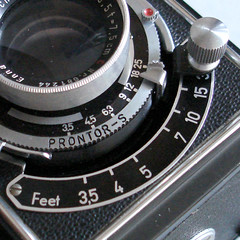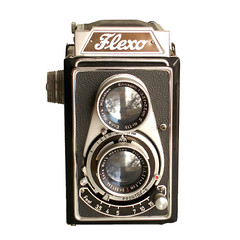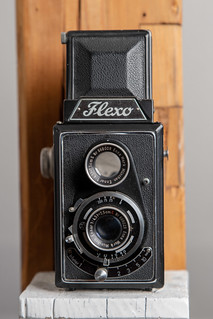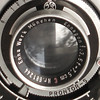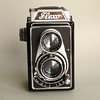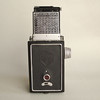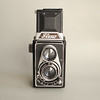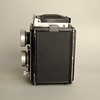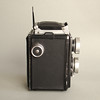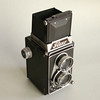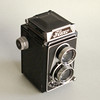The Flexo is a German TLR made by Lipca. Production started in 1948 with the first version and ended in 1951 with the fourth version after which a trademark dispute with Franke & Heidecke forced the name change to Flexora. It was the first model in a series of TLR's that include the Flexora's and Rollop's.
Of course many technical aspects of the Flexo agree with the Reflecta TLR that Kamera-Werk C. Richter build before and just after the second wold war.
There were 4 main versions of the Flexo build but deviations from these may be observed as camera production in those years sometimes called for improvisation.
The first Flexo version which was produced from 1948 can be easily identified as it has the lens engravings on the side of the front lens mount.
It has an uncoated Enna Ennar 3.5/7.5cm taking lens in either a Prontor-II or Prontor-S shutter.
Most of the production was for export according to a directive of the Military Government (occupying forces) at that time.
The second Flexo version was build from 1950. The lens engravings now moved to a more standard position, the front lens name ring.
The taking lens is from that time on coated and is either an Enna Ennar 4.5/7.5cm in a Vario shutter or an Ennar 3.5/7.5cm in a Prontor-S shutter.
During its production phase there were also modifications e.g. the introduction of flash synchronisation and another way to mount the magnifier.
The third Flexo version was build from 1951. The camera was updated with a (wire) sports finder. Lens/Shutter combinations stayed the same.
The fourth Flexo version was build from 1951. The camera received a reinforced bottom plate. The Lens/Shutter combinations were expanded with an Enna Ennagon 3.5/7.5cm in a Prontor-S shutter.
In the model depicted here, both lenses are Ennagon 3.5/7,5cm. They have identical specifications but for the white "s" and red "c" on the viewing and taking lens respectively. The lenses accept screw-in and push-on filters.
The shutter is a Prontor-S with speeds of B, 1-1/300s. It is set and fired by levers around the taking lens. Thus, the Flexo lacks a true shutter button, but it does have a cable release socket. Self-timer and bulb flash socket. An odd series of apertures 3.5, 4.5 6.3, 9, 12, 18 and 25 is marked on a scale under the taking lens. When set at maximum aperture, the shutter release lever actually touches the aperture lever. Focusing is done by an anchor under the taking lens, like on the Minolta Autocord I and the Meopta Flexaret VII. When focusing, only the lens tubes move; the front plate stays in place. At least two variations of this Flexo exist; one with a scale in feet and one with a meter scale.
The Flexo takes 6×6cm pictures on 620 or 120 film. The film is transported with a knob on the right of the camera. This knob is slightly conical and that makes advancing the film a little more comfortable. The Flexo has no frame counter; film advance is checked through a ruby window on the back. It has two different finders; a waist level finder with folding loupe, as do most TLRs, and a wire framefinder with an eyelet. This framefinder slides into the front plate.
Loading the film is done in an unusual way, or at least unusual for a TLR. In box cameras, this is a rather more common way of loading. Only the back plate opens; it is hinged and folds open. To load the film, the chamber has to be taken out. To do this, the winding knob should be pulled out.
This system was already in use on the Richter Reflecta TLR and was at that time intended as a way to circumvent Franke & Heidecke patents for the placing of the take-up spool in the space behind the mirror.
Images
Bibliography
- Personal Lipca research documentation, courtesy of long time Lipca collector and history investigator Herr Ulf Schopfer, Bad Pyrmont, Germany
- Peter Barz, article "Lipca Teil 1, eine Neugründung der Nachkriegszeit" in the German magazine "Photographica Cabinett 25/02"
- Peter Barz, article "Lipca Teil 2, Die Kameras de Lippischen Camerafabrik Richter & Fischer GmbH, Barntrup" in the German magazine "Photographica Cabinett 26/02"
Links

